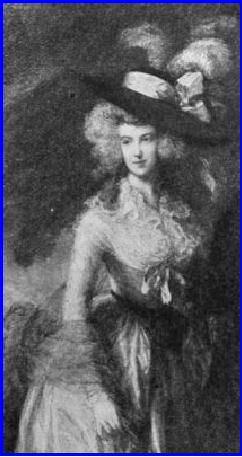 |
FOOTWEAR |
| << COLOUR IN WOMAN'S COSTUME |
| JEWELRY AS DECORATION >> |

A
sofa of contrasting colour, or black,
would have looked better in
the room, and
served as
immediate background for
gowns. It might have been
covered in dark
chintz, a
silk damask in one or several tones, or a
solid colour, since the
gowns
were of
delicate indefinite
shades.
One of
the sofas did have a
dark Chinese coat thrown over
the back, with the
intent,
no
doubt, of serving as effective
background, but the point
seemed to escape the
daintily
gowned young woman who
poured tea, for she
failed to take advantage of
it,
occupying the opposite end of the sofa. A
modern addition to a woman's
toilet is
a
large square of chiffon,
edged with narrow metal or
crystal fringe, or a gold
or
silver
flexible cord. This scarf is
always in beguiling contrast to
the costume, and
when
not being worn, is thrown
over the chair or end of sofa against
which our lady
reclines.
To a certain degree, this
portable background makes a
woman decorative
when
the wrong colour on a chair
might convert her lovely
gown into an eyesore.
One
woman we know, who has an
Empire room, admires the
lines of her sofa as
furniture,
but feels it ineffective
unless one reclines � la Mme.
R�camier. To
obviate
this difficulty, she has had
made a square (one and a
half yards), of
lovely
soft
mauve silk damask, lined
with satin charmeuse of the
same shade, and
weighted
by long, heavy tassels, at
the corners; this she
throws over the Empire
roll
and
a part of the seat, which
are done in antique green velvet.
Now the woman
seated
for conversation with arm
and elbow resting on the head,
looks at ease,--a
part
of the composition. The
square of soft, lined silk
serves at other times as
a
couvrepied.
CHAPTER
VII
FOOTWEAR
OOTWEAR
points
the costume; every child
should be taught this.
Give
most careful attention to
your extremities,--shoes, gloves and
hats.
The
genius of fashion's greatest
artist counts for naught if
his costume
may
not include hat, gloves,
shoes, and we would add,
umbrella, parasol, stick,
fan,
jewels;
in fact every detail.
If
you have the good sense to
go to one who deservedly ranks as an
authority on
line
and colour in woman's costume,
have also the wisdom to get
from this man or
woman
not merely your raiment; go
farther, and grasp as far as
you are able the
principles
underlying his or her
creations. Common sense
tells one that there
must
be
principles which underlie
the planning of every hat
and gown,--serious reasons
why
certain lines, colours and
details are employed.
Principles
have evolved and clarified
themselves in the long
journey which
textiles,
colours
and lines have made,
travelling down through the
ages. A great cathedral, a
beautiful
house, a perfect piece of
furniture, a portrait by a master,
sculpture which
is
an object of art, a costume
proclaimed as a success; all
are the results of
knowing
and
following laws. The clever
woman of slender means may
rival her friends
with
munition
incomes, if only she will go to an
expert with open mind, and
through the

thoughtful
purchase of a completed costume,--hat,
gown and all
accessories,--
learn
an artist-modiste's point of view.
Then, and we would put it in
italics; take
seriously,
with conviction, all his or
her instructions as to the way to
wear your
clothes.
Anyone can buy
costumes,
many can, perhaps own
far more than you,
but
it
is quite possible that no one can more
surely be a picture--a
delightfully
decorative
object on every occasion, than
you, who knows instinctively
(or has
been
taught), beyond all shadow
of doubt, how to put on and
then how to sit or
walk
in, your one tailored suit,
your one tea gown, your one
sport suit or ball
gown.
PLATE
X
An
ideal example of the typical
costume of
fashionable
England in the
eighteenth
century,
when
picturesqueness,
not
appropriateness,
was the demand of the
times.
This
picture is known as THE MORNING
PROMENADE:
SQUIRE
HALLET WITH HIS
LADY. Painted
by Thomas Gainsborough and
now
in the private collection of
Lord
Rothschild,
London.
Courtesy
of Braun & Co., New
York,
London & Paris
Eighteenth
Century England
Portrait
by Thomas
Gainsborough
Table of Contents:
- A FEW HINTS FOR THE NOVICE WHO WOULD PLAN HER COSTUMES
- THE LAWS UNDERLYING ALL COSTUMING OF WOMAN
- HOW TO DRESS YOUR TYPE
- THE PSYCHOLOGY OF CLOTHES
- ESTABLISH HABITS OF CARRIAGE WHICH CREATE GOOD LINE
- COLOUR IN WOMAN'S COSTUME
- FOOTWEAR
- JEWELRY AS DECORATION
- WOMAN DECORATIVE IN HER BOUDOIR
- WOMAN DECORATIVE IN HER SUN-ROOM
- I. WOMAN DECORATIVE IN HER GARDEN:WOMAN DECORATIVE ON THE LAWN
- WOMAN AS DECORATION WHEN SKATING
- WOMAN DECORATIVE IN HER MOTOR CAR
- HOW TO GO ABOUT PLANNING A PERIOD COSTUME
- I. THE STORY OF PERIOD COSTUMES:II. EGYPT AND ASSYRIA
- DEVELOPMENT OF GOTHIC COSTUME
- THE RENAISSANCE
- EIGHTEENTH CENTURY
- WOMAN IN THE VICTORIAN PERIOD
- SEX IN COSTUMING
- LINE AND COLOUR OF COSTUMES IN HUNGARY
- STUDYING LINE AND COLOUR IN RUSSIA
- MARK TWAIN'S LOVE OF COLOUR IN ALL COSTUMING
- THE ARTIST AND HIS COSTUME
- IDIOSYNCRASIES IN COSTUME
- NATIONALITY IN COSTUME
- MODELS
- WOMAN COSTUMED FOR HER WAR JOB
- IN CONCLUSION